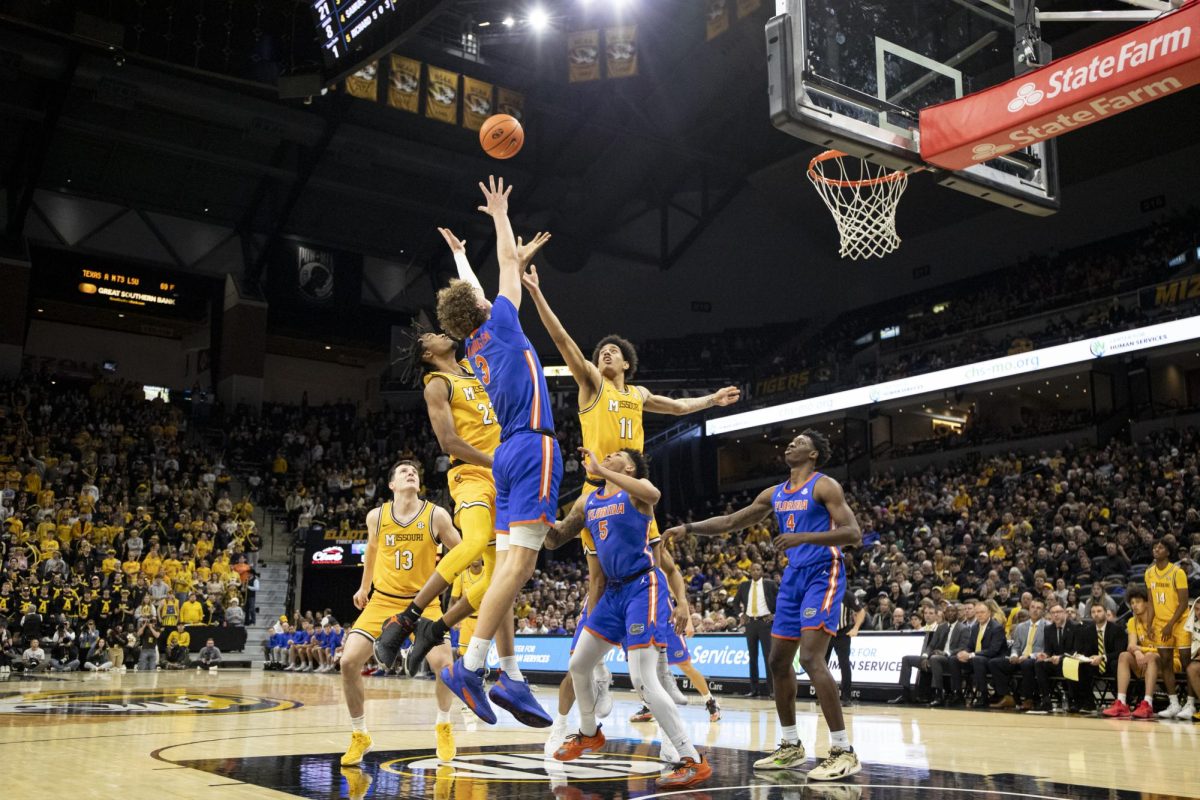The graduate student has improved in almost every offensive category, becoming the leader the Tigers desperately needed
Entering the 2023-24 basketball season, plenty of excitement surrounded the Missouri basketball program. The Tigers were coming off of a season that saw them finish fourth in the SEC with 25 wins, including a victory in the NCAA Tournament. The off-season saw some big recruiting wins as well. Head coach Dennis Gates secured commitments from six players with multiple seasons of Division I basketball under their belts, headlined by graduate transfers Caleb Grill and Connor Vanover, as well as junior Tamar Bates.
But even with plenty of optimism surrounding the team, Gates’ squad seemed to have one major area of uncertainty: who would be the number one scoring option?
Despite the roster having many seasoned veterans, none of them had ever been the primary option at any point in their collegiate careers.
Kobe Brown, D’Moi Hodge and DeAndre Gholston, three players who each held the leading role at different points in the last season, all moved on to their own professional careers in the summer.
This left a sizable hole which needed to be filled. Luckily for Gates, one of his team’s strengths this year is its depth, with the Tigers having 14 players who have all earned rotational minutes at varying points throughout the season. This has given him plenty of candidates for the job.
Graduate forward Noah Carter was the leading scorer amongst the returning Tigers, and was a successful second option on a Northern Iowa team that finished first in the Missouri Valley Conference in 2021-22.
Graduate guard Nick Honor started all 35 games for the Tigers in 2022-23 and took control of the majority of the team’s ball-handling duties.
Iowa State transfer Caleb Grill came to Columbia with a known affinity for the three-point shot. This, coupled with a heavy reliance on three-pointers in Gates’ offensive system, made Missouri seem like the perfect situation for the graduate guard to have a breakout year.
However, one name that was not mentioned as muchwas graduate guard Sean East II.
A year ago, almost all of East’s playtime was spent leading the Tigers’ second unit as the sixth man. His overall athleticism and ability to attack the rim made his playstyle a nice foil to Honor, who plays at a more methodical pace with a heavier reliance on his three-point shot.
However, through the first 15 games East has proven to be the answer for fans wondering who the offensive leader of this year’s team would be.
With so much talent graduating from the program, naturally there were going to be increased opportunities for returning players. So, while East seeing an increase in minutes may not have been a surprise for fans ahead of the season opener against Arkansas-Pine Bluff, but just how large of a role he would take on surely was not expected by some fans.
East has played in 496 minutes so far, which is the 2nd most among all SEC players. His usage rate, which is used to estimate the percentage of plays that a player contributes to the outcome of, has also skyrocketed. He has a usage rate of 23.9% thus far. For reference, Kobe Brown sat at 23.6% last year.
East’s control of the Tigers offense started the moment the season tipped-off. On the first play of the opener, East caught the ball at the top of the key, faked a hand-off to Carter while dribbling through to the right wing and called for a screen from senior Jesus Carralero Martin. East’s defender made a weak attempt to go over the top, not expecting the jumpshot, while Carralero’s defender sagged off to stop an attack on the rim. This allowed East the space needed to drain the three-pointer, a shot that he would have rarely even attempted last year, let alone converted on.
This play was a refreshing sight for Missouri fans. East was coming off a season where he shot just 22.1% from behind the arc, which allowed defenses to guard the perimeter more conservatively and load up more against attempts to attack the rim. This took away opportunities for East II to use his athleticism and drive for a finish close to the hoop, which was his most efficient way of scoring last season.
Thankfully for Missouri, the shot from the first play of the year was not a fluke. East is shooting a career-best 53.7% from three on 3.3 attempts per game, up 31.6% from a season ago.
As expected, becoming a weapon from long range has allowed East many more opportunities to attack the paint. He is averaging 4.6 shot attempts at the rim this season, where he is shooting 64.3%. This number is significantly increased from his 1.7 attempts last year.
Another benefit of getting more shots at the rim is an increase in free throw attempts. East II, who is a career 80% free throw shooter, earned less than two attempts per game from the charity stripe last season. This number has increased this year, as East is attempting 3.1 free throws per game.
The increased efficiency as well as more playing time is leading to the best year of East’s career in terms of scoring. He is averaging 17.3 points per game on 55% from the field, both career-highs. His 61.7% eFG, which takes into account the higher value of a three-point shot compared to a two-pointer, ranks second among SEC guards. He is the one of only three Tigers to score 20 points in a game this season, a mark he has reached in nine of Missouri’s first 15 games. He was only able to score 20 once last year against Southeast Missouri State.
Not only is East putting up impressive numbers more often, but he’s doing it against better competition. He scored 21 points against No. 2 Kansas at Allen Fieldhouse and had another 21-point outing on the road in a win over Pittsburgh.
It’s not just East’s scoring that is up either. His playmaking numbers are better too. East is averaging 3.7 assists per game, up from 2.5 last season. He also sports a 23.7 AST%, a stat that shows how often a player assists their teammates.
If you’re wondering how much faith Gates has in East as his go-to guy, look no further than Missouri’s come-from-behind win over Minnesota on Nov. 16.
East had struggled mightily in the game, shooting 3-of-11 from the field through the first 39 minutes. When it was getting down to the wire, Nick Honor and Tamar Bates were getting the majority of the shots, and it looked like one of the two could be the one to take the final shot.
But with 16.6 seconds on the clock and Missouri down one, Gates still trusted No. 55, East, enough to put the ball in his hands. The Tigers inbounded to East and let him go to work. He attacked a rub screen from Honor, pump faked hard enough to get his defender in the air and went up strong through the contact, scoring the basket and earning the foul. He knocked down the free throw, and Missouri came away victorious.
Although East has been Missouri’s most impactful player on the court this season, his contributions don’t stop when the final buzzer sounds.
Ahead of the game against Pittsburgh, East texted his head coach with an idea. Missouri was coming off a disappointing homestand loss to Jackson State, and didn’t perform as expected against South Carolina State and Loyola Maryland. Looking to provide a spark, East suggested moving Tamar Bates and sophomore Aidan Shaw into the starting lineup.
Gates once again trusted East and it proved to be a success as Missouri won 71-64 in their most complete performance of the season to that point. The line-up change seems to have stuck, as Bates hasn’t left the starting five and Shaw has been a starter for five of the seven games since East suggested the change .
East has also developed in terms of leadership ability, specifically in his relationship with freshman point guard Anthony Robinson II. Robinson, like East, relies heavily on his athleticism to succeed, so the connection between the two seems to be a natural fit. Gates told the media how East and Honor, “put [Robinson] through the ringer” in the off-season. This tough love has helped Robinson prepare to be a rotational piece for Missouri in his first season of college basketball.
East has successfully filled the void left by departing stars from last season both on the court and in the locker room. Amidst uncertainty around who would cement themselves as the leader of this year’s team, East’s transition from sixth man to the driving force of Missouri’s offense while also leaving a lasting impact on his younger teammates has been an unexpected highlight of this young season.
If he can prove that his play to this point is more than just a hot start to the season, Missouri will become a team that nobody wants to see despite their early struggles in conference play.
Edited by Quentin Corpuel | [email protected]
Copy edited by Sterling Sewell | [email protected]



















